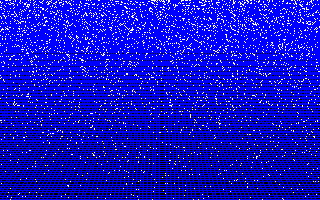Als Diskussionsmöglichkeit zu Burkhard Heims einheitlichen Feldtheorie mache ich mal diesen Thread auf.
Als relativ gut verständlicher Einstiegsartikel zu dieser Theorie sollte diese Artikel (englisch) genügen:
Und ich habe jetzt auch gleich mal selber eine Frage zu dieser Theorie:
Auf Seite 2 steht da unter dem Abschnitt "Maximum and Minimum Distance. The Metron" folgendes
Ich habe hier jetzt eine Frage zum Verständis obiger Behauptung.
Und zwar, warum sollte das Universum eine endliche Größe haben,
wenn die Kraft zwischen 2 Objekten, wie oben beschrieben, nach einer sehr großen Distanz gegen 0 geht?
Wenn man einem der Objekte eine zusätzliche Kraft hinzufügt (z.b. mit einem Raketenantrieb), dann müßte das Universum ja weiterwachsen, demnach ist es nicht endlich.
Es gibt da ja keine Mauer, bei dem die Objekte abprallen.
Warum sollte das Universum also endlich sein?
Als relativ gut verständlicher Einstiegsartikel zu dieser Theorie sollte diese Artikel (englisch) genügen:
Und ich habe jetzt auch gleich mal selber eine Frage zu dieser Theorie:
Auf Seite 2 steht da unter dem Abschnitt "Maximum and Minimum Distance. The Metron" folgendes
The existence of a field mass, mentioned in Section 1, leads to an modification of Newton’ law of gravitation.
Newton’ law is simple and specifies the force between two masses in terms of the distance seperating them. As is well known, the force is inversely proportional to the square of the distance.
Due to the existence of field mass the gravitational force in Heim’ theory is the solution of a so-called “transcendental“ equation, i.e. an algebraic equation having no simple solution. Nevertheless, approximate
analytical solutions, i.e. formulas, can be found for various ranges of the distance between two masses. Purely
numerical answers on a computer can, of course, be obtained for all distances.
As is to be expected, Heim’ law is virtually indistinguishable from Newton’ law out to distances of many light years (1 light year = 5.91 trillion (1012) miles). Thereafter, the force begins to weaken more rapidely than
Newton’ law and goes to zero at an approximate distance of 150 million light years. At still greater distances it becomes weakly repulsive. Finally, at a very great maximum distance it goes to zero and stays zero. This distance is significant for the size of the universe, because at distances exceeding it the force becomes
unphysical. Hence, greater distances cannot exist. The greatest possible distance in 3 dimensions is the the
diameter of the universe, which will be denoted by the letter D.
Newton’ law is simple and specifies the force between two masses in terms of the distance seperating them. As is well known, the force is inversely proportional to the square of the distance.
Due to the existence of field mass the gravitational force in Heim’ theory is the solution of a so-called “transcendental“ equation, i.e. an algebraic equation having no simple solution. Nevertheless, approximate
analytical solutions, i.e. formulas, can be found for various ranges of the distance between two masses. Purely
numerical answers on a computer can, of course, be obtained for all distances.
As is to be expected, Heim’ law is virtually indistinguishable from Newton’ law out to distances of many light years (1 light year = 5.91 trillion (1012) miles). Thereafter, the force begins to weaken more rapidely than
Newton’ law and goes to zero at an approximate distance of 150 million light years. At still greater distances it becomes weakly repulsive. Finally, at a very great maximum distance it goes to zero and stays zero. This distance is significant for the size of the universe, because at distances exceeding it the force becomes
unphysical. Hence, greater distances cannot exist. The greatest possible distance in 3 dimensions is the the
diameter of the universe, which will be denoted by the letter D.
Und zwar, warum sollte das Universum eine endliche Größe haben,
wenn die Kraft zwischen 2 Objekten, wie oben beschrieben, nach einer sehr großen Distanz gegen 0 geht?
Wenn man einem der Objekte eine zusätzliche Kraft hinzufügt (z.b. mit einem Raketenantrieb), dann müßte das Universum ja weiterwachsen, demnach ist es nicht endlich.
Es gibt da ja keine Mauer, bei dem die Objekte abprallen.
Warum sollte das Universum also endlich sein?





 ), dann sinkt nach dieser Feldtheorie die Kraft der Gravitation mit der Entfenrung schneller ab als nach dem klassischen newtonschen Mechanik und ist bei ungefährt 150 Mio Lj Entfernung gleich 0. Geht man wesentlich weiter darüber hinaus, verhält sich die Gravitationskraft nach dieser Feldtheorie als wäre sie nicht existent. (der Artikel bezeichnet es einfach als "unphysikalische", was wohl meint, dass man ab einer bestimmten Entfernung keine Vorhersage über die Kraft mehr machen kann) Aus diesem Grund sagt diese Theorie eine bestimmte endliche Größe für das Universum vorraus, die dem maximalen Wirkradius der Gravitatiion der enthaltenen Materie entspricht.
), dann sinkt nach dieser Feldtheorie die Kraft der Gravitation mit der Entfenrung schneller ab als nach dem klassischen newtonschen Mechanik und ist bei ungefährt 150 Mio Lj Entfernung gleich 0. Geht man wesentlich weiter darüber hinaus, verhält sich die Gravitationskraft nach dieser Feldtheorie als wäre sie nicht existent. (der Artikel bezeichnet es einfach als "unphysikalische", was wohl meint, dass man ab einer bestimmten Entfernung keine Vorhersage über die Kraft mehr machen kann) Aus diesem Grund sagt diese Theorie eine bestimmte endliche Größe für das Universum vorraus, die dem maximalen Wirkradius der Gravitatiion der enthaltenen Materie entspricht.




Kommentar